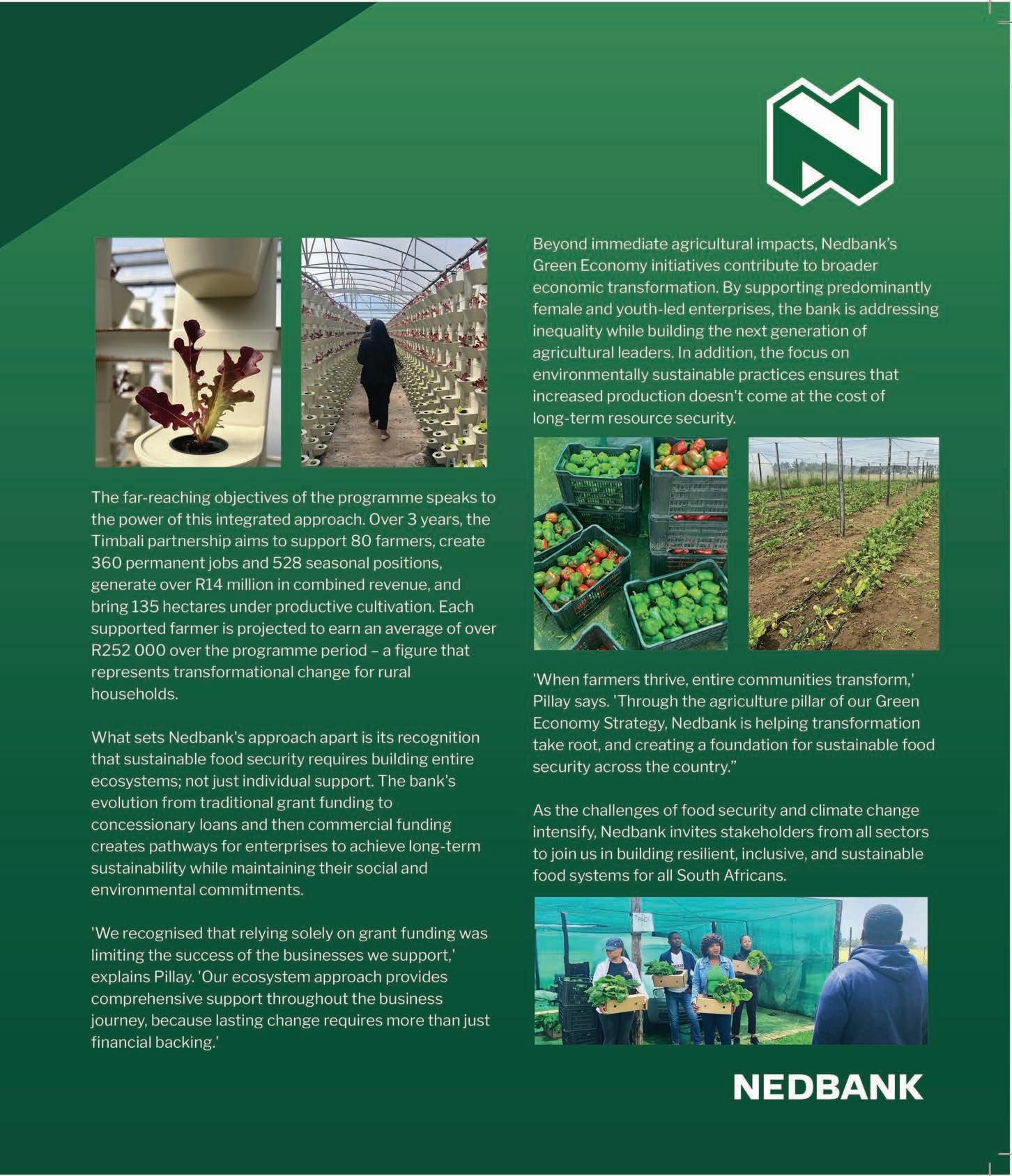

























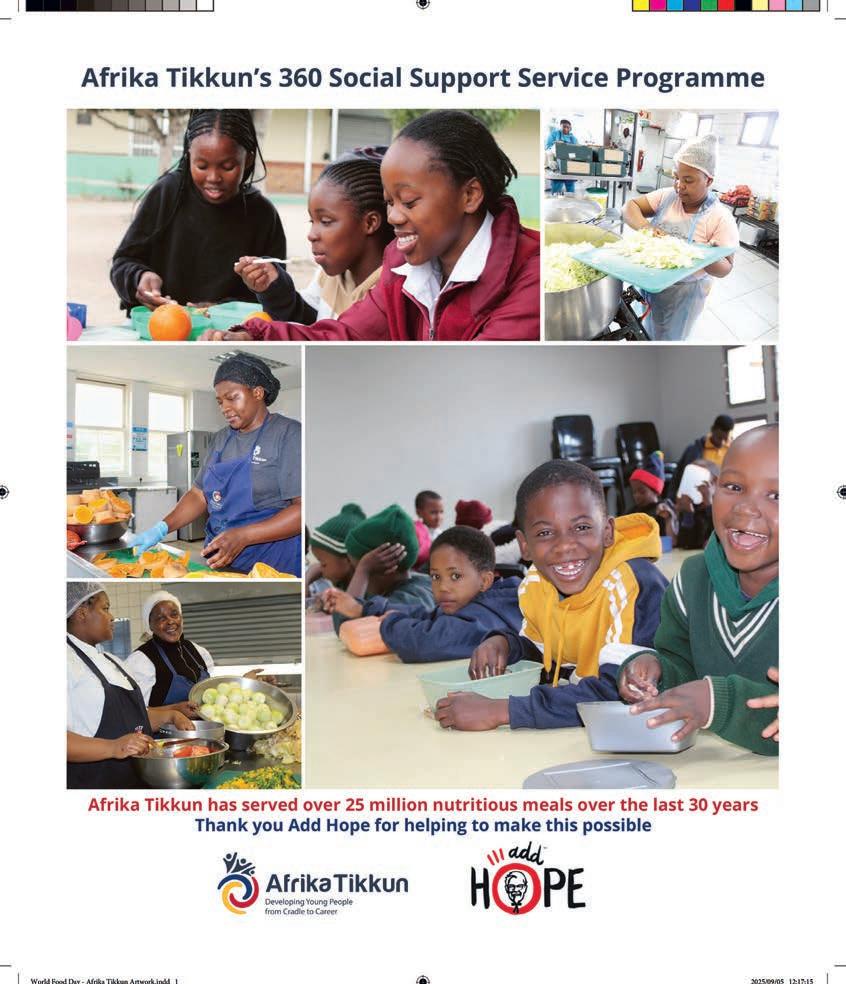

Connecting farms, families and futures


















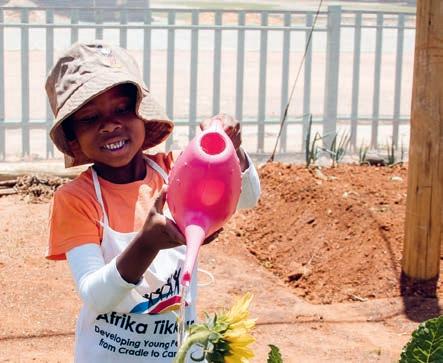
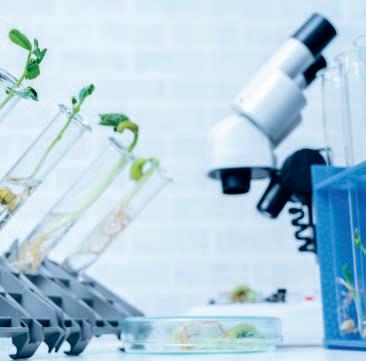



















The SPAR Group Ltd (SPAR or the Group) is a leading warehousing and distribution business listed on the Johannesburg Stock Exchange (JSE) in the Food and Drug Retailers sector. While the Group owns the SPAR retail brand, it primarily supports a network of independent retailers who trade under the SPAR name through its modern distribution centres.
SPAR South Africa, established in 1963, operates four retail formats designed to meet the diverse needs of shoppers: SPAR neighbourhood supermarkets, SPAR Express forecourt stores, KWIKSPAR convenience-focused stores, and SUPERSPAR supermarkets.
SPAR forms part of SPAR International, a global retail organisation that is present in 48 countries, operating 240 distribution centres and serving almost 14,7 million customers daily. Locally, the Group is headquartered in Durban and operates 10 distribution centres, serving 3,768 retail members through 14 store formats nationwide.
Beyond retail, SPAR is deeply committed to the communities it serves. Through its independent retailers, SPAR plays an active role in supporting local economies, creating opportunities, and ensuring customers have access to quality products at affordable prices.
For more information, visit: www.spar.co.za or https://thespargroup.com

Omnia is a global, diversified chemicals group, supplying chemicals and specialised services and solutions to the agriculture, mining and chemicals application industries.
Established over 70 years ago, Omnia is headquartered in Johannesburg, South Africa, with its main production facilities in Sasolburg, some 70kms south of Johannesburg.
Omnia’s global presence currently extends to 23 countries, with operations in Africa, Australia, Indonesia, Brazil, North America and China.
Omnia combines technical innovation and intellectual capital to add value for customers at every stage of the supply and service chain. Its portfolio of products and services supports sustainable agriculture and the responsible extraction of mining commodities.
In line with the company’s purpose of “innovating to enhance life, together creating a greener future”, Omnia’s products and service solutions promote the responsible use of chemicals for health, safety and a lower environmental impact, while increasing the use of cleaner technologies.
Omnia’s resilient business, supported by core operations, an integrated supply chain and investment in agricultural technologies, mining explosives and R&D, strengthens its market position and underpins its international diversification.
Omnia is listed on the JSE (OMN.JO) and A2X securities exchanges, with a market capitalisation of approximately R12 billion.
For more information, visit: www.omnia.co.za


PUBLISHED BY
Picasso Headline,
A proud division of Arena Holdings (Pty) Ltd, Hill on Empire, 16 Empire Road (cnr Hillside Road), Parktown, Johannesburg, 2193 PO Box 12500, Mill Street, Cape Town, 8010 www.businessmediamags.co.za
EDITORIAL
Editor: Elriza Theron
Content Manager: Raina Julies rainaj@picasso.co.za
Contributors: Jennifer Booth, Magda du Toit, Itumeleng Mogaki, Busani Moyo, Ivor Price
Copy Editor: Brenda Bryden
Content Co-ordinator: Natasha Maneveldt
Head of Design: Jayne Macé-Ferguson
Senior Designer: Mfundo Archie Ndzo
Cover Images: [graphicswizard]/123rf.com, [wizardx]/123rf.com, [alex011973]/123rf.com, supplied
SALES
Project Manager: Jerome van der Merwe jeromem@picasso.co.za
Tel: +27 21 469 2484 | 082 668 1496
Sales: Frank Simons
Production Editor: Shamiela Brenner
Advertising Co-ordinator: Johan Labuschagne Subscriptions and Distribution: Fatima Dramat, fatimad@picasso.co.za
Online Editor: Stacey Visser vissers@businessmediamags.co.za
Printing: CTP Printers, Cape Town
MANAGEMENT
Management Accountant: Deidre Musha
Business Manager: Lodewyk van der Walt General Manager, Magazines: Jocelyne Bayer


COPYRIGHT: No portion of this magazine may be reproduced in any form without written consent of the publisher. The publisher is not responsible for unsolicited material. World Food Day is published by Picasso Headline. The opinions expressed are not necessarily those of Picasso Headline. All advertisements/advertorials have been paid for and therefore do not carry any endorsement by the publisher.
World Food Day always makes me pause. It’s a moment to step back and remember just how connected we all are through food. Whether you’re a farmer, a scientist, a business leader, or simply someone deciding what to cook tonight, each of us has a role to play in shaping the food system.
In this issue, we’ve brought together stories that show the incredible diversity of those roles. Small-scale farmers, for example, produce nearly a third of the world’s food. Their resilience, often in the face of enormous challenges, reminds us that food security starts at the ground level, quite literally in the soil. At the other end of the spectrum, we explore the fascinating world of innovation, such as plant breeding tools that extend shelf life, future foods based on traditional crops, and even arti cial intelligence driving ef ciencies across the supply chain. It’s proof that the future of food isn’t somewhere far away; it’s already here.
7
We explore how innovation in plant breeding is reshaping the food chain.
We unpack how food safety depends on collective action, robust science and strong enforcement for a sustainable future.
13
We look at how technology and innovation are transforming food production for greater sustainability, nutrition and affordability.
19
We highlight how small-scale farmers drive food security and sustainability, but need policy support and innovation for impact.
We also look at food safety, the often invisible but essential foundation of trust in everything we eat. Without it, there can be no real security, no matter how much food we grow. And closer to home, organisations like Afrika Tikkun remind us that food is also about dignity, empowerment and hope, especially when it comes to investing in the next generation.
For me, the big takeaway is that when it comes to food, there’s no such thing as a bystander. Each of us, in our own way, is part of the recipe for resilience. On this World Food Day, I hope these stories inspire you, as they did me, to see your place in this bigger picture and to imagine how your choices can continue to build a fair and sustainable food system.
Elriza Theron Editor

For over three decades, Afrika Tikkun has broken cycles of poverty by investing in South Africa’s youth and creating lasting opportunities.
Exploring the innovations and collaborations shaping climate-resilient sustainable agriculture.
Young women farmers are driving transformation in South Africa’s agricultural sector.
Population growth and food security are among the most urgent challenges of our time – challenges that OMNIA is helping address

As global populations rise, the demand for food increases, yet many food systems are already under pressure. This is especially evident in Africa, the fastest-growing continent by population, where one in ve people face hunger, according to the World Health Organisation’s July 2025 The State of Food Security and Nutrition in the World report.
Omnia is at the forefront of addressing these global challenges. With deep roots in South Africa and operations across 23 countries, the group supports sustainable agriculture by combining science, innovation and high-impact solutions to help produce more food using fewer resources.
Omnia Group CEO Seelan Gobalsamy explains: “Food security is a global challenge, but its impact is especially severe in Africa. Omnia’s purpose is clear: to help feed the world’s growing population not by using more fertiliser or water, but by empowering farmers to produce more with less, through greener and more sustainable agricultural practices.
Founded in 1953, Omnia has developed into a diversi ed industrial group, focusing on two key sectors: agriculture and mining. Agriculture is central to food security, while mining drives job creation, industrial development and economic growth.
Omnia’s Nutriology® model goes far beyond fertiliser supply. It empowers farmers to manage risk more effectively by integrating value-added products, analytical services, precision data and expert agronomic insight to boost yields, restore soil health, reduce input costs and ultimately increase the producers’ return on investment.
Omnia’s international business is focused on biostimulants, with manufacturing based in Australia and operations spanning Australia, Brazil and the United States. It develops and produces eco-friendly solutions and science-based farming inputs. Exporting to over 30 countries worldwide, these innovative solutions enhance crop performance and the ef cacy of fertiliser.
“SUSTAINABILITY IS NOT A REQUIREMENT; IT IS CORE TO OUR STRATEGY BECAUSE IT REFLECTS OUR RESPONSIBILITY TO THE ENVIRONMENT AND CREATES LONG-TERM VALUE FOR OUR CUSTOMERS AND SUPPLIERS.” – SEELAN GOBALSAMY
In mining, Omnia’s BME business delivers integrated solutions tailored to improve ef ciency, increase precision and reduce costs and environmental impact. Innovative technologies support safer extraction and recovery of minerals, helping mines operate more responsibly.
“Our mining partners face growing pressure to meet environmental, social and governance (ESG) commitments. We provide the technology and solutions to extract resources safely while protecting workforces, communities and the environment,” Gobalsamy adds.
Omnia’s success is underpinned by a resilient and integrated manufacturing and supply chain that supports both agriculture and mining. The group has strengthened its ammonia value chain through alternative sourcing and strategic investment in logistics infrastructure to ensure security of supply to customers. Key developments include increased use of road and rail ammonia tankers and the commissioning of a 5 000-tonne ammonium nitrate storage tank at the Sasolburg manufacturing facility. Enhanced throughput and reliability in nitric acid plants have supported growth in third-party ammonia derivatives and a shift towards long-term contracts.
“Farmers cannot afford to wait for fertiliser when the rains arrive, and mine operations must avoid delays when blasting schedules are tight. Omnia’s ability to procure, manufacture and deliver with precision and reliability is what sets us apart. That operational agility and resilience makes us a compelling investment. Our strong balance sheet, disciplined capital allocation and reliability of manufacturing and supply chain give customers and investors con dence,” says Tiaan Kotzé, Omnia’s chief operating of cer.
Omnia’s commitment extends beyond production and supply. It invests in social initiatives that deliver lasting impact. Its partnerships with credible long-standing implementation partners enable Omnia to
equip young South Africans with practical farming skills. Since 2023, Omnia’s food security programmes have positively impacted over 25 000 households across the host communities surrounding its operations.
Job creation and youth employment begin within the organisation. Each year, Omnia recruits approximately one per cent of its workforce as graduates through programmes that build supply chain, technical, nance, IT and other disciplines. These graduates gain hands-on experience and mentorship to prepare for long-term careers.
“Purpose is not a slogan for us; it de nes how we operate,” says Gobalsamy. “Omnia’s commitment to innovating to enhance life and together creating a greener future is re ected in everything we do, from investing in community development and supporting education to promoting sustainability and addressing social challenges. This purpose-driven approach ensures that our commercial success uplifts communities and safeguards the environment.”
Omnia’s sustainability journey is driven by innovation and technology. Since 2020, the group has reduced scope 1 and 2 carbon emissions by 78 per cent through investments in solar and other alternative energy sources and cleaner processes. Millions of litres of water are recycled annually, and used oil is repurposed in blasting operations to reduce waste for customers. For the year ending 31 March 2025, solar energy use increased by 55 per cent, water recycled reached 194ML and used oil consumption improved to 27ML, reducing the risk of water contamination.
These efforts are guided by Omnia’s ESG strategy, which is anchored in measurable outcomes.
“Sustainability is not a requirement; it is core to our strategy because it re ects our responsibility to the environment and

THE GROUP HAS STRENGTHENED ITS AMMONIA
creates long-term value for our customers and suppliers,” says Gobalsamy. “This is not about ticking boxes. It is about securing a sustainable future for the next generation.”
Omnia’s corporate growth strategy is built on responsible industrial leadership. The group holds a Level 2 B-BBEE rating, re ecting its commitment to transformation and inclusive development. Its zero-harm principles guide every operational decision, and its mining business is regularly recognised for outstanding safety performance.
Omnia’s nancial performance remains robust. For the year ending 31 March 2025, group revenue rose by 3 per cent to R23-billion, driven by higher volumes, strong cash generation and a continued focus on customer-centric innovation and sustainability. The mining segment is a key growth sector, and BME is well-positioned to be a globally successful business.
“While nancial performance is important, true success lies in the lasting impact we create for our stakeholders and communities where we operate,” says Gobalsamy.
“Financial strength allows us to reinvest in people, technology and sustainability,” adds Gobalsamy. “Our sites in Sasolburg, Dryden, Losberg and across South Africa and the world re ect that reinvestment, where world-class teams develop solutions that are globally competitive.”
With a global workforce of nearly 4 000, Omnia plays a vital role in building competitive industries in South Africa and beyond.

Although Omnia operates globally, South Africa remains the hub of its innovation and manufacturing. At its agship Sasolburg facility, the group manages an expansive site that spans a signi cant footprint, comprising manufacturing plants, solar installations, water treatment systems and R&D laboratories. The site also hosts the largest soil-testing facility in the southern hemisphere, analysing over 500 000 samples annually to enable precision farming and applications.
“South Africa is where we began, and it remains central to our operations. The technologies and solutions we develop here are deployed globally. From Sasolburg, we serve our agriculture and mining customers in Africa and export competitive solutions to Australia, Indonesia, North America and Brazil,” says Gobalsamy.
Omnia’s impact is underpinned by its ability to connect purpose, innovation and resilience. By supporting farmers to grow more food and enabling mines to operate more ef ciently and safely, the group contributes directly to food security, job creation, economic development and environmental sustainability.
“We are more than a supplier. We are partners to our customers, working alongside them to deliver value-added solutions that improve lives in a greener way. When farmers, mines and industries thrive, entire societies thrive,” Gobalsamy concludes.

Solving the twin challenges of intense weather and food security requires modern technology, coupled with advanced scientifi c research, writes ABRAHAM VERMEULEN , commercial director for Africa and Middle East at Corteva Agriscience
Sub-Saharan Africa faces an increased risk of climate vulnerability, as extreme and intense weather impacts increase in frequency, causing huge disruption to food production systems. A recent UN estimate indicates that there has been a nearly 40 per cent increase in malnutrition in Sub-Saharan Africa in the last decade. Locally, approximately 28 per cent of children under the age of ve are malnourished, due to a lack of nutritious food availability.
Cortega Agriscience is a proponent of sustainable agriculture and, as a research and development (R&D)-focused business, aims to leverage technology to help solve some of these climate-related challenges.
Corteva is proud to call South Africa one of our key markets, where we operate as a local partner. With advanced research hubs in Delmas and Potchefstroom and eld trials conducted across over 100 locations, we generate more than ve million data points annually to ensure our seed varieties and crop protection solutions are nely tuned to local environmental and agronomic conditions.
Through these efforts, we are proud to have played our part and helped drive a 36 per cent increase in maize yields over the past decade, delivering three million additional tonnes of maize while using 200 000 fewer hectares. This kind of productivity gain is crucial for a continent where every hectare must count and every harvest matters.
Our innovation pipeline is grounded in the needs of South African farmers – commercial and emerging. With hybrids and varieties

stress-tested under local conditions and sustainable crop protection, our approach is centred on helping farmers do more with less, while safeguarding their long-term productivity. Globally, for the past ve years, we have invested more than $6-billion into R&D. Locally, our R&D network serves local market needs and is an innovation and knowledge base for the wider African markets.
Our focus and investment cover multiple pillars, from capacity building and skills development to enterprise development and empowering women farmers. Annually, we offer a 12-month internship programme to 20–25 young graduates, offering on-the-job experience across all business elds.
Our bursary programme, which has an annual intake of 16 students, goes beyond nancial support, providing students with two opportunities for work exposure at key Corteva sites.
A key pillar of our transformation strategy is empowering rural women. Through our SoilSistas programme, in partnership with organisations such as the Gordon Institute of Business Science, we equip women farmers with the knowledge, resources and networks needed to succeed.
Our commitment to South Africa goes hand in hand with a rm belief in partnership. We know that agricultural transformation cannot happen
in isolation. It requires co-ordination across government, private sector, research institutions and farmers.
South Africa adopted biotech maize in 1998, becoming the fth country globally. This move, backed by supportive regulation, improved access to advanced traits. Today, South Africa’s maize yield averages 5.7 tonnes per hectare, far above the Sub-Saharan average of 2.2 tonnes per hectare, re ecting disparities in access to technology, inputs and agronomic practices.
South Africa’s early adoption of agricultural biotechnology – and its current leadership in maize yields across Sub-Saharan Africa –demonstrates the power of smart, science-based policy. We must ensure regulation continues to evolve in a way that supports both innovation and inclusion.
Ultimately, our vision is clear: to help build resilient agricultural systems that feed people, sustain livelihoods, ensure consumer safety and protect our natural resources.
In South Africa, this means continuing to invest in technology, talent and transformation. It means ensuring innovation doesn’t stop at commercial farms, but reaches every smallholder, rural woman and emerging farmer across the country.
At Corteva, we don’t just work in agriculture; we grow with it. We are proud to stand with South Africa’s farmers, scientists and communities in shaping a more sustainable and food-secure future.











How innovation in plant breeding is reshaping the food chain



ELRIZA THERON writes that in a world where millions still go hungry each night, the sheer scale of food waste is staggering
Globally, a third of all food produced never reaches a plate. This is not just a loss of nourishment, but a squandering of the water, land, energy, soil and seed invested in growing it. For the agricultural value chain, this inef ciency represents both a challenge and a signi cant opportunity.
The Food and Agriculture Organization de nes food loss as reductions in quantity or quality before produce reaches the consumer, covering production, transportation, storage and packaging. Estimates suggest that up to 14 per cent of food is lost at this stage due to pre- and post-harvest challenges.
Food waste, by contrast, occurs further downstream, where retailers or consumers discard edible, good-quality food. In developed countries, waste of this kind amounts to an estimated 230 million tonnes a year, roughly equivalent to the annual food output of Sub-Saharan Africa.
Modern agriculture is increasingly turning to science to counter these losses. New breeding tools such as CRISPR (clustered regularly interspaced short palindromic repeats) are enabling faster, more precise interventions than traditional breeding methods. By editing genes linked to vulnerability, resilience and shelf life, science is directly tackling inef ciencies across the supply chain. At farm level, CRISPR is helping crops resist pests, diseases and environmental stresses. In Africa, for example, gene editing has created banana varieties resistant to Xanthomonas Wilt, a bacterial disease that has devastated yields in East and Central Africa. Similarly, researchers have used
CRISPR to develop sorghum that withstands Striga, a parasitic weed that cripples cereal and legume harvests.
Chantel Arendse, lead for plant biotechnology at CropLife South Africa, highlights the broader impact: “Sustaining food production within the new reality of changing climates requires crops that are designed to be more resilient and better able to withstand harsher growing conditions.”
She notes that new product pipelines include varieties engineered for tolerance to heat, cold, drought and soil salinity, allowing farmers to protect yields under increasingly volatile conditions. The outcome is not only reduced losses, but also more ef cient use of resources, an important factor for business sustainability strategies.
In developed economies, consumer-facing waste remains a serious challenge. Perfectly edible food is often rejected for minor cosmetic imperfections or spoils before purchase or use. Here, too, gene editing offers a way forward.
By moderating the production of ethylene, the natural hormone that drives ripening, CRISPR has been used to slow degradation in perishable produce. Tomatoes, for instance, have been enhanced to retain freshness for longer, extending shelf life and reducing retail shrinkage.
Elsewhere, researchers have reduced the enzymes in apples and potatoes that cause browning when cut or bruised. This not only appeals visually to consumers, but also reduces rejections, limiting unnecessary disposal. Mangoes, citrus and other fruits prone to spoilage in transit are also bene tting from resistance technologies against post-harvest diseases, a valuable gain, especially in regions with limited cold-chain logistics.
For the agri-food industry, these innovations are not simply scienti c breakthroughs; they are commercially relevant solutions to one of the biggest inef ciencies in the supply chain. Less waste means better margins, reduced environmental footprint and stronger supply resilience.
Arendse stresses that the bene ts will only scale with the right policy framework: “The uptake of agricultural innovations to contribute meaningfully at scale requires an enabling and consistent global regulatory environment to unlock the technology’s full potential.”
Businesses, particularly in food retail and distribution, also have a role in shifting consumer expectations. Cosmetic standards and overstocking practices directly drive waste. By embracing more resilient crops and adjusting supply models, companies can save both food and costs.

While technology can transform food production and preservation, individuals must also take responsibility. From planning meals to valuing produce with small imperfections, consumers are critical to closing the loop. The business sector, meanwhile, is uniquely positioned to lead by example, embedding innovation and responsibility throughout supply chains.
Science is offering the tools for us to minimise our food waste. The challenge now is ensuring they are applied widely enough to transform the food system for the long term.
Follow: Chantel Arendse www.linkedin.com/in/chantel-arendse-062347150 CropLife South Africa www.linkedin.com/company/croplife-south-africa
Food safety relies on collective, consistent action across the supply chain, robust science and strong enforcement to ensure a sustainable future, writes BUSANI MOYO

As the world celebrates World Food Day and its theme, “Hand in Hand for a Better Future”, it’s clear that a sustainable future is impossible without safe food. Food safety is the invisible bedrock of public health and food security, a goal achieved not by a single entity, but through a dedicated, collaborative effort. While the science behind keeping our food safe is robust, insights from leading South African experts reveal that building this better future requires more than just knowledge; it demands consistent, collective action from all players in the chain.

The journey from farm to fork is a chain built on mutual trust where every participant works hand in hand.
Mthokozisi Nkosi, managing director of ASC Consultants, a rm specialising in food safety and quality, paints a vivid picture of this interdependence.
“If the farmer supplying the baby spinach has used illegal agricultural products, it doesn’t matter what the processor does afterwards; the product is already compromised,” he says. “The reverse is also true. The farmer can deliver clean, safe produce, but if the middleman uses dirty wash water, contamination can be introduced later.”
This collaborative ecosystem is essential for building what Shivani Moodley, quality assurance manager at Danone Southern Africa, calls a “resilient food system where risks are identi ed early, standards are upheld and trust is earned”. Everyone shares responsibility, from farmers implementing best practices and packaging suppliers using food-grade materials to regulators conducting oversight and consumers washing produce before use. Each action contributes to the collective goal of a safer food future.
A better future begins at the source. At farm level, science provides the tools for proactively preventing biological and chemical hazards. Moodley points to biological threats, such as foot-and-mouth disease, as signi cant risks. Nkosi highlights the long-term dangers of chemical residues if agrochemicals are not used according to label instructions, and heavy metals in soil and water.
The most effective strategy, however, is not just detecting these hazards, but preventing them from occurring in the rst place.
“Detection is less important than prevention,” states Peter Gordon, chief executive of cer of the South African Meat Processors Association. “Good hygiene, together with
good manufacturing practices and instilling a food safety culture in your business, is key.”
Science-based interventions provide the blueprint. Moodley notes that cost-effective protocols, such as structured cleaning, controlled farm access, pest management and proper worker hygiene, are fundamental. These practices are formalised through standards like good agricultural practices that give farmers a clear framework for minimising risks from the very start.
South Africa boasts a strong regulatory framework, with experts agreeing that national standards are well-aligned with global benchmarks like the Codex Alimentarius. “South Africa has world-class food safety regulations,” Gordon con rms, a sentiment echoed by Nkosi, who points to comprehensive local standards.
However, this strong foundation could be undermined by a lack of enforcement.
“Enforcement should be consistent,” Gordon emphasises, highlighting that responsibility falls to municipal authorities with vastly different resources. This leads to reactive, rather than proactive, oversight. High-pro le “food safety blitzes” make headlines after an outbreak, but fail to create systemic change. “Are we simply waiting for the next food scare before reacting in the same way again?” Gordon asks.
Nkosi agrees, noting that government oversight often fades once a crisis subsides, and municipal of cers may lack the ongoing training needed to apply complex frameworks effectively. If one of the key partners in the compliance chain cannot consistently play its part, the entire system is weakened.
To move hand in hand toward a better future, the science of safe food must be matched by the discipline of consistent action. World-class regulations are only meaningful when enforced fairly and predictably across the board. A truly safe and secure food future cannot be left to chance; it must be built daily through the unwavering, shared commitment of all.
Follow: Mthokozisi Nkosi www.linkedin.com/in/mthokozisi-nkosi-0738a0a7 Shivani Moodley www.linkedin.com/in/shivani-sawu-moodley-45a0496a Peter Gordon www.linkedin.com/in/peter-gordon-17a76822

With millions going hungry, alleviating food security means tackling structural imbalances, writes
TASNEEM
Affairs Director, KAL Group.
South Africa’s food security remains a pressing concern. In a country as agriculturally rich as ours, it is troubling that farming households themselves go hungry.
According to Statistics South Africa’s Food Security Report 2019, 2022 and 2023, 3.7 million households face moderate to severe food insecurity, with 1.5 million experiencing severe hunger. This stark reality highlights structural imbalances in our food system that require urgent attention.
Food security is linked to economic inclusion, education and environmental sustainability. That’s why targeted initiatives in this space are crucial to alleviating hunger and building stronger communities.

KAL Group’s commitment to food security is about building long-term community resilience. It rests on three pillars: empowering small-scale farmers, collaborating with commercial farmers and food redistribution partners and leveraging our network to channel food to bene ciaries in need.
Our investment in the development of small-scale farmers is a key pillar of our food security strategy to grow emerging agri-entrepreneurs. Small-scale farmers are key to unlocking rural development and poverty alleviation, but often struggle to access markets, resources and training that help them thrive. By investing in their growth, we aim to contribute to more sustainable local food systems and stronger rural economies.
Through the KAL Academy, we have invested in the development of small-scale
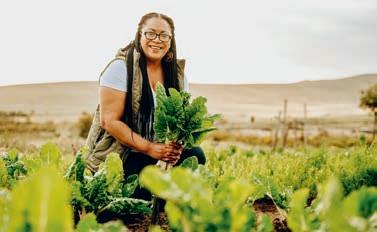
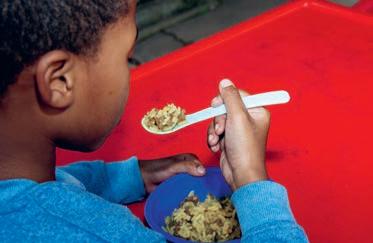
farmers since 2009. We provide practical technical training and business development support – helping farmers not just to grow crops, but also grow businesses. To date, 515 farmers have been trained, with over R12.4-million invested since inception and R1.2-million in 2024 alone.
However, numbers only tell part of the story. The true impact lies in the journeys of the individuals who come through our doors.
Wayne Mans eld, a citrus farmer and KAL Academy alumnus who graduated from our Academy’s Mixed Farming Programme, has since expanded his own farming business, fostering local job creation. Through further support from the KAL Group Enterprise Development programme, he continues to boost his productivity and ef ciency.
In partnership with OneFarm Share, the programme channels fresh produce from small-scale and commercial farmers to registered nonpro t organisations like soup kitchens. This approach not only feeds vulnerable households, but also reduces food waste and supports the livelihoods of farmers. Since 2023, the programme has rescued and distributed over 890 tonnes of food, providing ingredients for 3.5 million meals.
KAL Group employees are central to our sustainability work. In partnership with Rise Against Hunger, team members have packed over 44 000 meals for early childhood development centres, feeding more than 190 learners for an entire year. These engagements foster a personal connection between employees and our social impact goals – and that matters.
Enabling food security is core to our business. By focusing on environmental, social and governance issues aligned with our operations, we ensure our efforts are impactful. This means close collaboration across our entire network –internal teams, suppliers, customers, government departments and community role players – to avoid siloed efforts and drive tangible change in the regions we operate.
While handouts and emergency interventions have their place, as a country we must invest in systems that empower people. The future of food security depends on creating access to markets, supporting local producers and opening opportunities across the value chain. Strengthening these foundations can help build a more inclusive, resilient food system, a mission highlighted each year on World Food Day, reminding us of our collective responsibility to ensure no one goes hungry.

Our Harvesting Hope initiative connects surplus produce with communities in need. SCAN THIS QR CODE TO GO TO THE KAL GROUP WEBSITE For
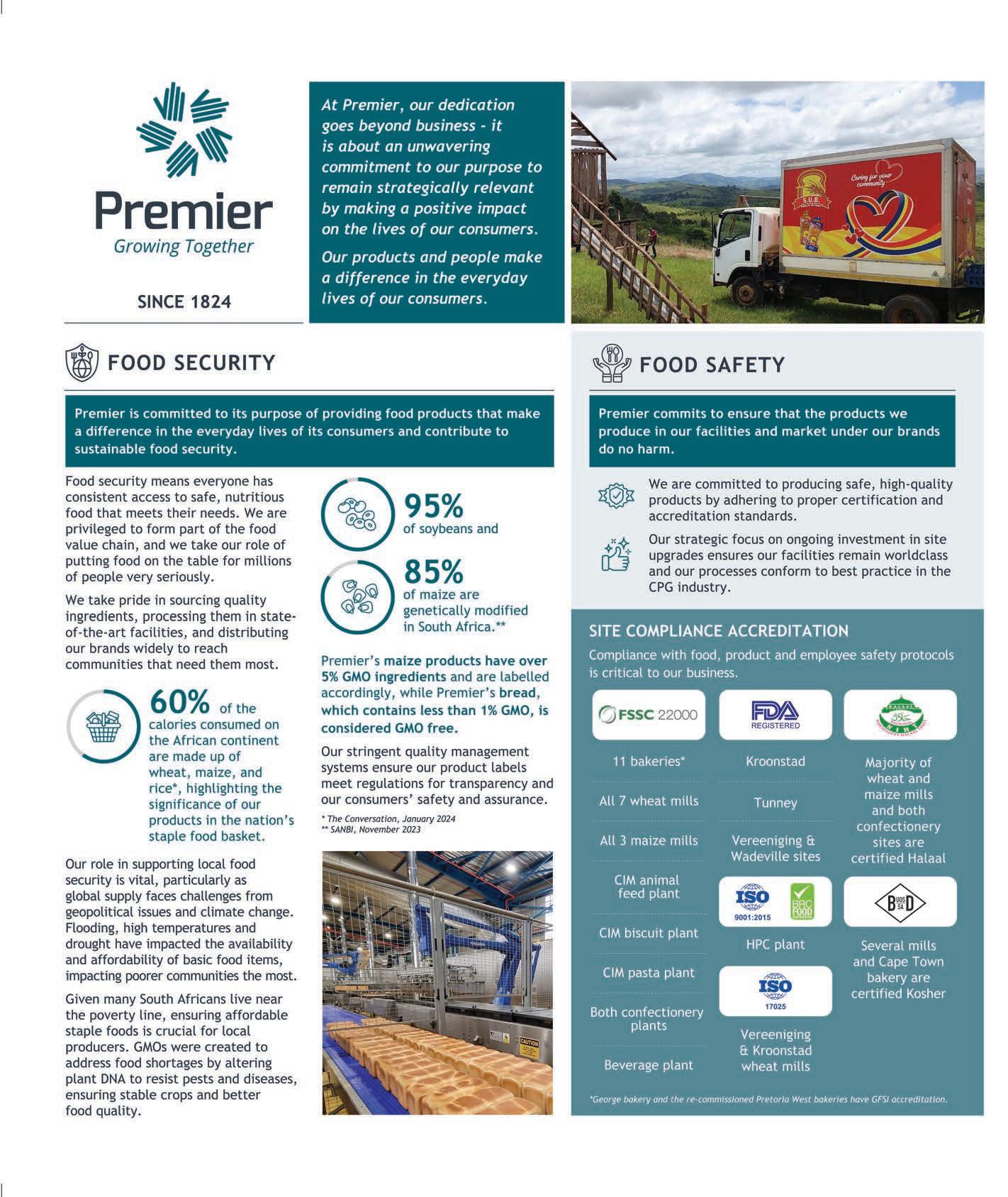

ACTIONAID SOUTH AFRICA , a human rights-based entity, views the issues of gender justice, good governance and the eradication of poverty as the keys to building a more equal society

Guided by feminist analysis and a human rights-based approach, ActionAid South Africa (AASA) is a nationally registered civil society organisation that works with people living in poverty and exclusion to build sustainable, people-centred and just alternatives to injustice and inequality. It is a part of the ActionAid International Federation.
Sakhile Zungu, interim country programme manager at AASA, says the organisation integrates water, sanitation and hygiene (WASH) into its work by focusing on women’s and girls’ rights to water and sanitation. It also addresses infrastructure issues, advocates for increased government investment in WASH, and works with communities to implement sustainable solutions to poverty and injustice.
“A good example is the efforts undertaken in the OR Tambo District Municipality in the Eastern Cape, which experienced heavy ooding in June. The rains caused extensive damage to households, infrastructure and properties. We initiated a humanitarian response, partnering with local organisations in uMthatha, as well as City Hope, Oxfam SA, uBuntu Restoration and the Farmers Network SA, to collaborate and provide a positive intervention,” he says.
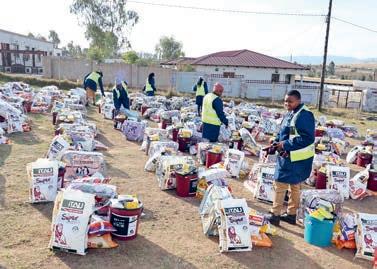
“AASA and its partners supported the affected population through the provision of WASH goods, nonfood items (NFI), and food security, among others. We delivered food parcels and health and sanitary kits to over 1 200 vulnerable households. In addition, we offered psychosocial support – in the form of group therapy and one-on-one counselling sessions for survivors – and gender-based violence (GBV) training.”
Zungu explains that these services were delivered across the 13 centres housing the displaced and included food parcels containing the basic food requirements for an entire family, as well as NFIs, including building materials, stoves, pots, dishes and blankets –critical elements needed to restart their lives.
“Additional support was in the form of infant packs, speci cally for those with newborns, including diapers and baby clothing, and some 800 school uniforms, books and stationery for the displaced children.
“In crises like these, there is often an increase in GBV because of the stressful situation. We provided GBV training on spaces where victims can be safe, how to reach out for help and how to relate to one another in an environment where everyone is cramped together and tempers can easily reach boiling point.”
“AT AASA, WE APPROACH SITUATIONS LIKE THESE FROM A PLACE OF MUTUAL RESPECT, UNDERSTANDING AND CARE.” – SAKHILE ZUNGU
The organisation further ensured mobile kitchens were provided in some of the centres, which, as community halls, were not designed to care for the displaced. Oxfam SA supplied JoJo tanks for water storage so everyone had access to safe, potable water.
“At AASA, we approach situations like these from a place of mutual respect, understanding and care. For us, it is about more than merely providing support. It is equally about ensuring that survivors are treated as human beings,” he comments.
“This is why we speak to their physical, emotional and mental health needs. Anyone who went through what these communities did would experience psychological trauma. For us, it is about delivering mental healthcare support, wrapped up in simple and basic humanity.” The organisation currently provides this and many other types of support in six of the country’s nine provinces.
“Other focuses include advancing climate resilience, prioritising the inclusion of marginalised communities in the green transition, strengthening women’s rights and gender equality, advocating for law reform and championing youth economic empowerment and leadership.
“We identify as a human rights-based entity, viewing the issues of gender justice, good governance and the eradication of poverty as the keys to building a more equal society and ghting the existing systems of injustice. We do this by working at the grassroots level and partnering with underprivileged communities, rather than simply viewing them as bene ciaries,” concludes Zungu.
ActionAid is a global movement of people working together to further human rights for all and defeat poverty.




For more information: www.actionaid.org www.twitter.com/actionaid www.facebook.com/actionaid
Technology and innovation are transforming food production, boosting sustainability, nutrition and affordability while meeting diverse consumer and environmental needs, writes MAGDA DU TOIT

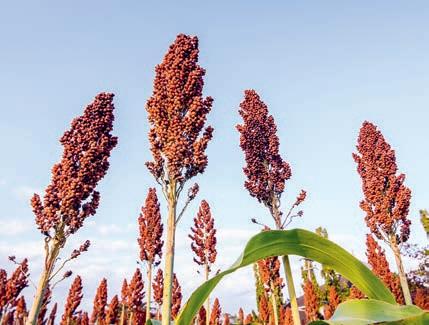
The global food value chain faces many challenges. Surging input and commodity prices, together with global market dynamics, are creating uncertainty and turbulence. Yet, amid these challenges, industry researchers and investors are working tirelessly to develop new and better technologies that are poised to shape the future of food and agriculture.
Professor Hettie Schönfeldt of the Faculty of Natural and Agricultural Sciences at the University of Pretoria says agriculture is adopting precision technologies, improved cultivars and conservation agriculture practices, including soil-friendly bacteria, to grow more food on the same land while using fewer resources.
“With a large portion of agricultural land facing moderate to severe degradation, and nearly all crops dependent on soil health, soil restoration has become critical for food security. With less farmland and more mouths to feed, innovations in food production, processing and distribution are essential for future food security,” says Professor Schönfeldt.

She says new crop varieties resistant to pests and diseases, smarter irrigation systems and digital farming tools are already boosting yields and helping farmers remain resilient, despite the challenges they face.
Technology innovations focusing on precision agriculture also support production ef ciency, as well as farm input ef cacy. Professor Schönfeldt predicts that arti cial intelligence will continue to have an impact on the food industry, driving ef ciencies across the supply chain from farm to table.
One of the grain crops that has stepped forward in this quest for sustainable food production is sorghum. Marguerite Pienaar, an economist at Grain SA, says sorghum is an important staple grain for millions of people. “Sorghum is known for its ability to withstand adverse conditions such as drought, heat and waterlogging caused by erratic rainfall.”

Pienaar points out that sorghum can be used to make bread, porridges, soups and even cakes for human consumption, as well as malt in the production of alcoholic beverages such as opaque beer, traditional sorghum beer (umqombothi ), and nonalcoholic drinks ( mageu). “Additionally, sorghum is also used for livestock and poultry feed due to its high nutritional value and digestibility.”
Potchefstroom-based company Sense Food Product Development specialises in food product development, product innovation, extrusion, consumer buying behaviour and product appearance tests.
Izelri Marx, co-director at the company, explains that they have developed a range of sorghum products, including full-grain porridge, full-grain instant cereal, malted centres for chocolates, beer mageu and sorghum savoury snacks. “As an ancient grain, sorghum is ideal to supplement diets of consumers, including those in the high-end market focusing on health products. It is gluten-free so can be a great alternative for people suffering from gluten intolerance,” Marx points out.

“INNOVATIONS IN FOOD PRODUCTION, PROCESSING AND DISTRIBUTION ARE ESSENTIAL FOR FUTURE FOOD SECURITY.”
– PROFESSOR HETTIE SCHÖNFELDT
Humanity is facing an increase in insulin resistance, often caused by consuming too many simple carbohydrates. Carbohydrates break down into simple sugars and can wreak havoc on blood glucose levels in the body, leading to type 2 diabetes or causing chaos for those already living with diabetes.
“The complex carbohydrate composition and tannin-rich bran of sorghum contain certain enzymes that inhibit the absorption of starch by the body, which can help to regulate insulin and glucose levels in the body,” she remarks.
“Innovation is not only happening on farms; it can also be seen on supermarket shelves,” says Dr Carmen Muller from the Department of Animal Science at the University of Pretoria. Marx agrees and notes that as a food product development consultancy working at the intersection of consumer demands and manufacturing realities, they witness rst-hand how technology is transforming both what consumers want and how manufacturers can deliver it at scale.

“The most signi cant shift we are seeing is the integration of automation and robotics in production lines, where manufacturers can now achieve consistent quality while dramatically reducing labour costs and human error. Advanced sensor technologies and arti cial intelligence-powered quality control systems are enabling real-time monitoring throughout the production process, allowing manufacturers to detect deviations instantly,” Marx explains.
She says what excites them is how manufacturing advances are shaping innovation. “Smaller food companies can now access sophisticated production technologies that were once exclusive to multinational corporations, allowing them to compete on quality and functionality. We are helping clients develop products using precision automated systems that would have been impossible to scale economically just ve years ago, creating opportunities for entirely new product categories.”
According to Dr Muller, consumers are increasingly seeking foods that are nutritious, affordable and aligned with their cultural preferences. She points out, however, that

this presents a challenge. “Many so-called future foods, such as plant-based alternatives to meat, are highly processed and sometimes high in sodium, signi cantly more so than their animal source counterparts.” She warns that just because a product is plant-based does not automatically make it healthier.
Dr Muller adds that true innovation must balance nutrition, affordability and cultural relevance to create products that genuinely bene t consumers. “Current food trends re ect these priorities. People want convenient, quick-to-prepare foods that are still nourishing. They are paying closer attention to labels and increasingly demand products that align with their values, whether organic, sustainable or locally produced. These trends occur within a highly diverse landscape of dietary habits and cultural traditions, meaning food innovation must deliver not only new products, but also solutions that respect local preferences, budgets and trust,” she says.
Marx notes that they are seeing remarkable convergence where consumer demands for complex bene ts meet advanced manufacturing capabilities in their consultations. “Clients are increasingly asking us to create foods that deliver multiple bene ts simultaneously, products that are indulgent yet healthy, convenient yet premium, globally inspired yet locally relevant.”
She says this complexity in demand requires sophisticated production solutions, such as computer-controlled extrusion systems that can create novel textures consistently across large runs, high-pressure processing technologies that extend shelf life without arti cial preservatives and enzymatic processing that modi es proteins to enhance both nutrition and functionality.
“We use advanced sensory analysis, coupled with real-time production monitoring, to ensure products meet consumer expectations batch after batch. The most exciting developments involve what we call intelligent manufacturing, which refers to production systems that adapt processing parameters based on ingredient variations and environmental conditions, ensuring consistent quality regardless of external variables.”
Rising food prices remain a major concern for households. “Access to affordable, nutritious food is no longer a luxury; it is essential for feeding the nation. Innovation in agriculture and food production must therefore focus not just on creating new products, but on keeping food within reach for all income groups. Higher-yield crops, ef cient supply chains and smarter product design can all help ensure that people can eat well without breaking their budgets,” notes Dr Muller.
“Ultimately, the future of food innovation lies in solutions that combine current knowledge with everyday nutrition. It is about producing smarter, fairer and more sustainable foods that people want to eat, while ensuring affordability and accessibility across a diverse and growing population,” Dr Muller says.
The food industry faces no shortage of challenges, but along with it comes opportunity, Marx says: “Technological innovation offers the chance to reimagine crop production, streamline supply chains, develop new food products and build the economy, thereby paving the way for the availability of healthier and more sustainable food.”
The future belongs to manufacturers who can deliver products that make consumers’ lives easier while aligning with their values around health, sustainability and authenticity.
Follow: Prof Hettie Schonfeldt www.linkedin.com/in/hettieschonfeldt
Dr Carmen Muller www.linkedin.com/in/vanniekerkcarmen/ Izelri Marx www.linkedin.com/in/izelri-marx-458b27124 Marguerite Pienaar www.linkedin.com/in/marguerite-pienaar-998a28114
HORTGRO writes that South Africa has taken the lead as the Southern Hemisphere’s
Since 2023, according to data released by the World Apple and Pear Association, South Africa has held the title of the largest apple exporter in the Southern Hemisphere, surpassing Chile, which had long dominated the position. This milestone is more than a statistic – it re ects years of investment, innovation and resilience in the country’s fruit industry.
South Africa’s apple industry is inherently export-driven, with an average of 45 per cent of local production shipped to 86 countries worldwide. The sector has bene tted signi cantly from sustained investment since 2008, which spurred growth in orchard hectares, the replacement of marginal orchards with improved varieties and rootstocks and the adoption of advanced production technologies. These include high-density plantings and protective netting – innovations that have boosted both yields and export volumes. Over the last eight years alone, total apple production in South Africa has grown by 30 per cent.
Although South Africa already bene ts from widespread international market access, the focus for new opportunities is now on Asia and the Far East. Thailand recently reopened its market to South African apples after a 16-year break, with the rst shipments arriving in March. China, which has long been a priority, has also been an established market for South African apples for the past decade.
The Port of Cape Town is the backbone of South Africa’s key fruit exports. Recently, it has faced major logistical challenges, including outdated equipment, mismanaged funds and low productivity. Encouragingly, the outlook has improved with the introduction of new management structures and the upcoming commissioning of modern equipment, which is expected to reduce bottlenecks and make the export process more ef cient.
Chilean apple production has been heavily restricted over the past 15 years due to
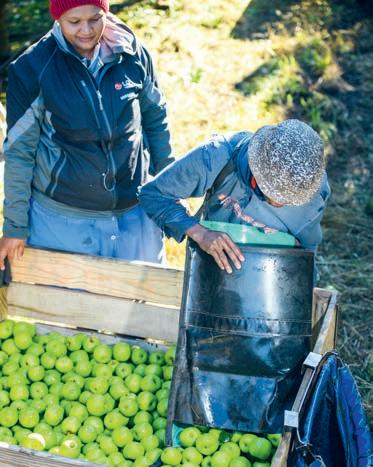
droughts and other adverse weather conditions. This has created opportunities for South Africa to increase its global presence. Meanwhile, South African apples have gained a reputation for exceptional eating quality and consistent standards, thereby boosting con dence in the country’s produce.
In 2022, South Africa and Chile were still neck and neck. However, by 2023, South Africa had surpassed its rival to become the largest apple exporter in the Southern Hemisphere.
Data from the World Apple and Pear Association highlights the shift: between 2016 and projected volumes for 2025, Chile’s apple production is expected to decline by 44 per cent, with exports down by 32 per cent. In contrast, South Africa’s production has grown markedly, and its exports have surged by 51 per cent.
While holding the top spot is never guaranteed, South Africa remains optimistic about sustained growth in both production and exports in the medium term. The industry’s goal is clear: to establish South Africa as the preferred supplier of premium-quality apples to global markets.
Hortgro is the South African deciduous fruit grower association, representing 1 128 pome (apples, pears) and stone (apricots, nectarines, peaches, plums and cherries) producers. An industry employing 63 832 people with 255 329 dependants.
Several factors give South Africa a sustainable advantage over Chile. Innovative research and world-class data systems help ensure competitiveness. The country also bene ts from geographic proximity to key markets in Europe, the Middle East and Africa – shorter transit times reduce the risk of spoilage and produce fresher fruit on arrival.
Robust phytosanitary standards have helped South Africa to maintain and grow access to high-value markets. Meanwhile, the country’s varied varietal selection enables it to better cater to regional preferences than many of its rivals.
Global apple production is facing increasing uncertainty as climate change impacts harvests worldwide. Both Chile and South Africa remain vulnerable to these changes. However, South Africa’s proactive strategies, combined with its reputation for quality, position the industry well to overcome challenges and strengthen its leadership role.
South Africa’s apple industry has never been better positioned to excel. With its record of growth, investment and quality, the sector is poised to remain a trusted partner to global markets – and a symbol of agricultural achievement for the Southern Hemisphere.

SCAN THIS QR CODE TO GO TO THE HORTGRO WEBSITE

SA grootste appeluitvoerder in Suidelike Halfrond - Hortgro published on 29 May 2025

For more information: +27 (0)21 870 2900 info@hortgro.co.za www.hortgro.co.za
For over 30 years, FOOD & TREES FOR AFRICA has been a foundational force in South Africa’s food security landscape. The organisation explains its food security pillar

Our diverse portfolio of food security initiatives, all rooted in sustainable agriculture, addresses hunger from every angle. From nourishing young minds with learner nutrition programmes in early childhood development centres and schools to developing thriving community and enterprise farms, Food & Trees for Africa (FTA) cultivates sustainable change through reliable solutions. What sets us apart is an agile, culturally and geographically agnostic intervention model – proven successful across South Africa and the wider Sub-Saharan region – that focuses on understanding the local social context and including bene ciaries as partners throughout the entire intervention process.
Food security interventions in South Africa face systemic challenges that often undermine their long-term success. Historically, many programmes have been hindered by two key issues: rst, a reliance on a patriarchal understanding of social development, and second, a signi cant mismatch in expectations – often unintentional – between donors, implementing partners and bene ciaries. Successfully implementing these programmes demands a rare blend of
expertise, including professional project management, deep social development experience, strong technical skills in sustainable agriculture and appropriate metrics for long-term impact measurement (preferably across multiple seasons). Simply put, not every organisation is equipped to, nor should every group, be the recipient of specialised food security funds. A sobering reality remains. Historically, it’s safe to estimate that most organisations achieve a less than 50 per cent long-term success rate upon exiting a food security social development intervention.

Across more than 300 projects in the last nancial year, FTA achieved an unprecedented 92 per cent success rate with food security interventions across South Africa. This exceptional performance is rooted in three distinct, data-driven mechanisms that form our competitive edge:
1. Proprietary Data and Targeting. We maintain one of the country’s largest “clean” food security databases, encompassing thousands of schools, community farms, market gardens and enterprise farmers. Our internal de nitions, based on land parcel size, bene ciary numbers and speci c desired outcomes, allow us to precision-match bene ciaries to donor strategies (for example, selecting woman-run, income-focused projects in the Eastern Cape).
2. Unique pre-intervention assessment. Our robust assessment processes are designed to predict success. We gather both crucial situational data (such as water availability and soil quality) and vital behavioural data – a key often overlooked factor in social development. This unique process allows us to accurately rank a project’s potential for success before any intervention begins.
3. Impact-Driven M&E. We have built a formidable monitoring and evaluation (M&E) system, relying on metrics developed internally over many years. This system doesn’t just keep a project on track; it measures and ensures the intended long-term impact is realised by the end of the intervention period.


Food security is the fundamental building block for all social progress in South Africa, yet millions still face chronic hunger. This is not merely a welfare issue; it is an economic and developmental imperative that corporate South Africa cannot afford to ignore.
A lack of reliable, nutritious food creates a crippling ripple effect: hungry learners cannot concentrate, leading directly to diminished academic performance and high drop-out rates. This undermines the future skills pipeline. Furthermore, malnutrition compromises a child’s health and physical development, impacts sports participation and strains public health systems.
By investing in sustainable food security initiatives, such as community gardens and enterprise farms, corporations are not just providing meals. They are building community resilience, fostering long-term economic inclusion and securing the foundation for better education, health and social stability. True corporate impact must address the root cause of poverty, and in South Africa, that starts with a secure food system.
It is a common misconception in the social development sector that food security projects are simple, requiring little specialised expertise. Just as you wouldn’t ask a farmer to draft your legal contract, effective food security implementation is a specialised profession. A successful intervention requires far more
than planting seeds; it demands a complex blend of professional project management, sustainable agriculture expertise, social dynamic understanding, skills development and rigorous impact measurement.
The unfortunate reality is that trying to manage these intricate variables entirely in-house often leads to suboptimal outcomes, wasting valuable corporate social investment or enterprise supplier development resources. To safeguard your investment and maximise your social return, you should partner with an established, experienced professional organisation. By engaging an experienced
partner with a proven track record, you ensure your project navigates the complex expectations of donors and bene ciaries alike, transforming investment into measurable, sustainable community change.
We value partnerships built on mutual trust and sustained effort. Just as in any successful relationship, we advise potential partners to start strategically and build momentum over time. To meet your speci c budgetary, operational and strategic needs, we offer a range of proven food security initiatives tailored for maximum impact.
For the sake of both parties, we prioritise successful, forward-looking projects. We generally advise against trying to “ x” pre-existing, failed interventions – it often requires disproportionate resource allocation with diminished results. Similarly, we respect the privacy and stability of our successful bene ciary partners; our focus is on ensuring their ongoing success with appropriate support, not diverting their attention.
Finally, effective food security doesn’t happen overnight. If your goal is truly sustainable impact, a long-term strategic view is essential. For our colleagues in communication, remember, achieving strong underlying fundamentals always creates an organic, compelling story of impact thereafter.
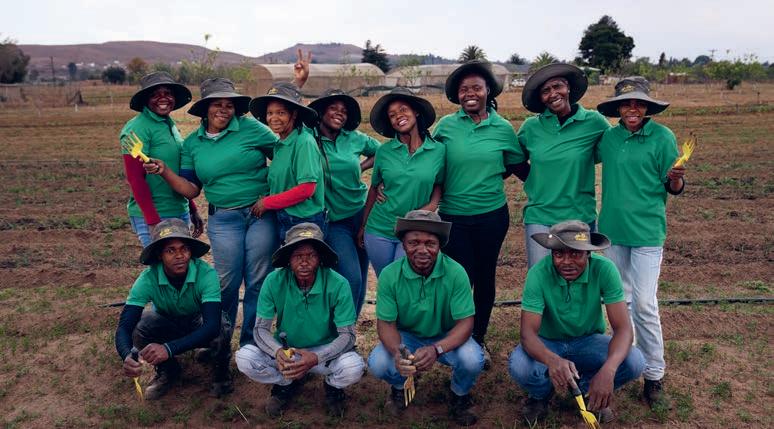
Follow:











ITUMELENG MOGAKI shares that small-scale farmers drive food security and sustainability in South Africa, but need policy support, investment and innovation for greater impact
Research from Bayer Crop Science shows that farms smaller than two hectares produce roughly 35 per cent of the world’s food, while in Asia and Sub-Saharan Africa, small-scale farmers supply up to 80 per cent of the food consumed.
In South Africa, where only 36.5 per cent of households are food secure and 17.5 per cent face severe food insecurity, small-scale farmers remain essential to building sustainable and resilient food systems.
In the Mopani District of Limpopo, Nomsa Ngwenya, founder of Ntl Baraka Eco-Farming, is showing how small-scale farmers can strengthen food systems. With a master’s degree in agricultural science, she chose to establish an organic farm, producing cocktail tomatoes, herbs and moringa.

“It wasn’t easy in the beginning,” she recalls.
“Without international certi cation or reliable transport, getting my products to market was very dif cult.” Her turning point came in 2022 when she joined the SPAR Rural Hub farmer development programme, which equips emerging farmers with training, resources and market access.
In 2023, she was named Female Farmer of the Year at the Kagiso SPAR Agri-Awards and used her prize money to invest in solar-powered irrigation to boost productivity and climate resilience.
Today, her farm supplies vegetables to hawkers, households and local stores, while employing 16 full-time staff and up to 25 seasonal workers during peak periods. Internationally, she exports natural ingredients, such as moringa, to Europe and plans to expand into Dubai. “We started small, but our footprint is growing.”
Sustainability is central to her model. She harvests rainwater through canals and a holding dam, composts organic waste, uses mulch to conserve soil moisture and plants moringa trees that absorb carbon dioxide. “Every practice on the farm is designed with climate-smart farming in mind,” she says.
Yet challenges persist. Market access, infrastructure and water rights remain obstacles. “Policies should be clearer for small-scale farmers so that we understand and can comply,” she says, calling for more end-to-end support and guided investment. “If farmers are supported according to their actual needs, we can grow stronger businesses and uplift others,” Ngwenya adds.
In Magaliesburg, North West province, Nompumelo Mpisekhaya, founder of KwaMtshali Farms, has built a diverse enterprise, producing yoghurt, eggs and seasonal vegetables. The farm supplies SPAR outlets, independent retailers and households through direct-to-client boxes.
KwaMtshali is rooted in regenerative agriculture. “Our focus is on sustainable principles for future conservation,” says Mpisekhaya. Animal waste is recycled as natural manure, while discarded crops are reused as mulch to protect and enrich soil. These practices improve resilience, conserve water and reduce dependence on external inputs.
However, nancial and market barriers limit growth. Distribution costs also weigh heavily on small-scale producers, making it dif cult to secure stable markets or expand employment.
With the right policies, investment and access to markets, KwaMtshali aims to
scale its impact, delivering nutritious food, sustainable employment and climate-smart practices that strengthen South Africa’s agricultural future.
Roscoe van Wyk, research fellow at Stellenbosch Business School, echoes that small-scale farmers need a mix of policy support, investment and technology. “Innovations, such as climate-smart agriculture and digital tools, can help farmers boost productivity, build resilience and ensure long-term sustainability,” he says. Practices like drought-tolerant crops, agroforestry, rotational grazing and rainwater harvesting are vital to protect soil health and diversify incomes.

“Digital tools are proving transformative by delivering weather alerts, pest warnings and planting advice directly to mobile phones, while mobile banking, crop insurance and digital marketplaces give farmers access to nance and buyers. Affordable innovations like drip irrigation and mobile soil-testing kits further support productivity,” says van Wyk.
He adds that inclusive policies, ranging from securing land rights to establishing local agri-hubs, will not only strengthen the position of small-scale farmers, but also allow them to thrive alongside larger commercial enterprises, ensuring they share in support structures and opportunities for growth.
Follow: Nomsa Ngwenya www.linkedin.com/in/nomsa-ngwenya-94676881
Baraka Eco-Farming https://www.baraka-farming.com
KwaMtshali Farms https://kwamtshalifarms.co.za
Roscoe van Wyk www.linkedin.com/in/roscoe-van-wyk-70733a70
For more than three decades, Afrika Tikkun, an award-winning nonprofit organisation, has been working to break cycles of poverty by investing in the youth of the country. By
ELRIZA THERON

At its core, Afrika Tikkun believes that transformation begins not with charity, but with empowerment. Its Cradle-to-Career model has become a blueprint for holistic development, nurturing children from their earliest years through to the point where they step into meaningful work. The philosophy is that, if you equip young people with education, nutrition, health, social support and pathways to employment, you create citizens capable of rewriting their own futures.
One of Afrika Tikkun’s insights is that no child can thrive on an empty stomach. Malnutrition remains an underacknowledged barrier to learning and emotional growth. Hunger diminishes attention spans, weakens immune systems and shackles potential long before young people ever enter the job market.
That is why food security forms a cornerstone of Afrika Tikkun’s mission. In the rst half of 2025, the organisation provided more than 855 000 nutritious meals across its centres, along with 1 878 food parcels for families in urgent need. Beyond children, senior citizens also bene t from daily meals, ensuring dignity and community care stretch across generations.
The impact of this work is not achieved in isolation. Afrika Tikkun has been championing the idea that business, government and civil society must work hand in hand to create sustainable change. Partnerships are catalysts for systemic solutions, not merely just fundraising tools. One such example is the long-standing collaboration with KFC’s Add
Hope initiative, which strengthens nutrition programmes and extends the reach of meal provision. This partnership illustrates what can happen when corporates align their social investment with grassroots expertise.
Afrika Tikkun’s story is not only about feeding the youth. It is about preparing them for a future where they can stand independently. The organisation’s agripreneurship programmes marry food security with economic empowerment, equipping young people to participate in sustainable food production and small-scale enterprise. This is an approach that resonates with South Africa’s urgent need for job creation. The country’s labour market craves in-demand skills, and Afrika Tikkun has made it its mission to ensure young people leave its programmes ready to contribute to and shape the economy of tomorrow.
In 2025, Afrika Tikkun was honoured as South Africa’s Best NGO at the CSI Legacy Awards, a recognition not just of longevity, but also of scale and consistency. Over 2 million young lives have been enriched, more than 25 million meals have been served, and healthcare, education and social support have been delivered to hundreds of thousands of families. Today, the organisation supports over 40 000 children and youth through ve centres of excellence and four training hubs nationwide. Behind these statistics are human stories, such as that of a teenager who stays in school because her daily meal is guaranteed,
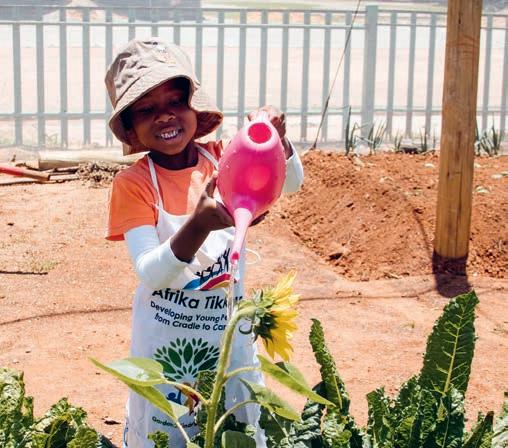
a young man who learns digital skills and secures his rst job, or a grandmother who no longer goes to bed hungry.
For South Africa’s business leaders, Afrika Tikkun offers more than a corporate social responsibility checkbox. It offers a chance to invest in the country’s human capital and be part of a movement that builds resilience, dignity and opportunity at scale.
Tiyani Mohlaba, chief operating of cer of Afrika Tikkun, says: “Afrika Tikkun’s journey is not about charity; it is about building an ecosystem of empowerment. Thirty years on, the organisation continues to stand as proof that when society rallies around its youth, the return on investment is exponential, because when a child eats, learns and grows, they don’t just change their own life, they change the destiny of a nation.” He concludes by noting “we are able to continue to transform the lives of our youth through signi cant partnerships, such as our KFC Add Hope partnership, and many others, for which we are incredibly grateful.”

“AFRIKA TIKKUN’S JOURNEY IS NOT ABOUT CHARITY; IT IS ABOUT BUILDING AN ECOSYSTEM OF EMPOWERMENT.” – TIYANI MOHLABA.
Follow: Afrika Tikkun www.linkedin.com/company/afrikatikkun www.instagram.com/afrikatikkun www.facebook.com/AfrikaTikkunNPC
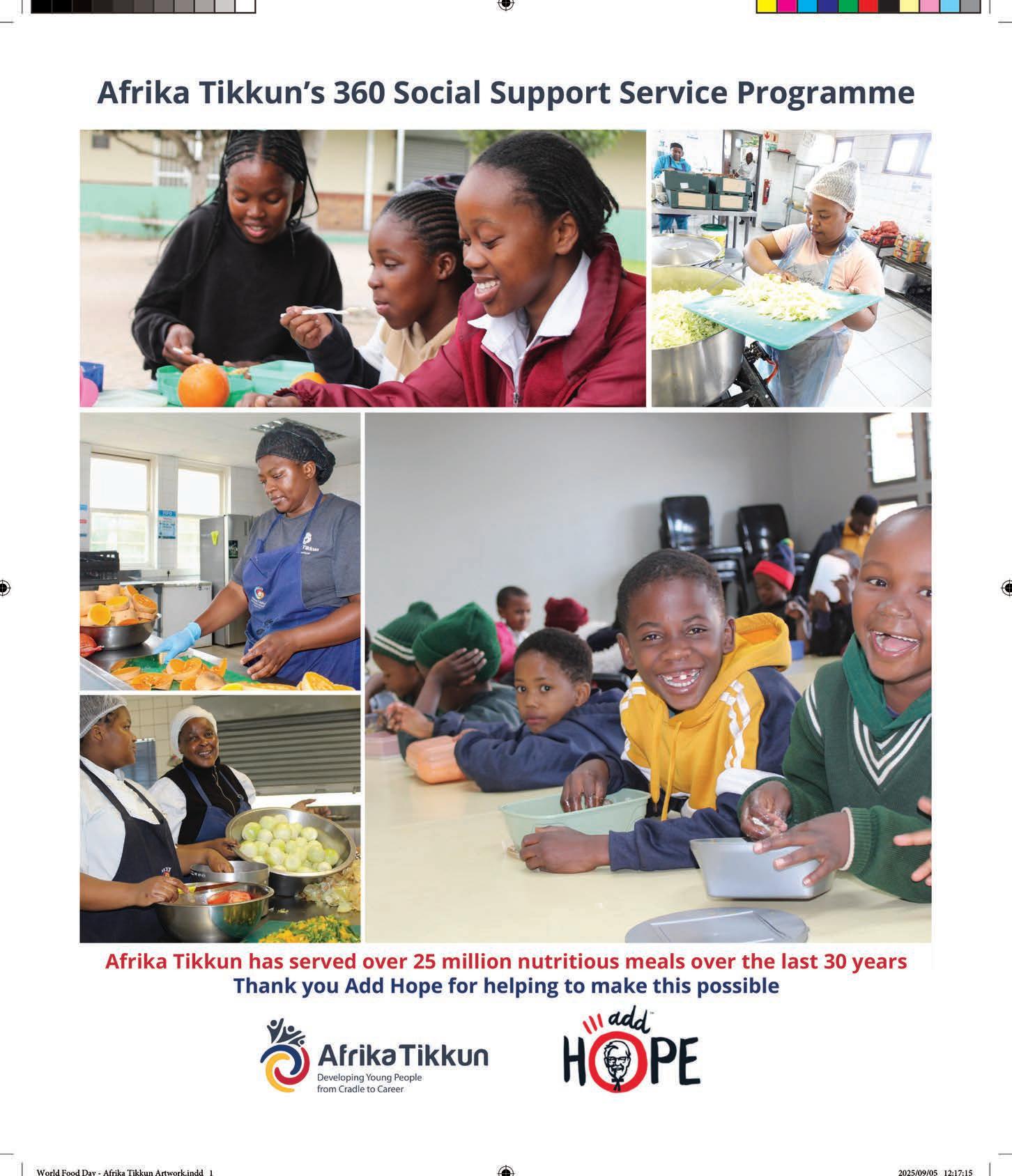
HIVOS SOUTHERN AFRICA explains how its Voices for Just Climate Action project assists Chongwe residents in Zambia to fight climate change, and how its partnership with Kasisi Agricultural Training College is helping teach farmers in other areas about sustainable agriculture

Towards the east of Zambia’s capital city, Lusaka, is the largely rural city of Chongwe. Here, the adverse effects of climate change are clear to see. Driving through surrounding dried-up rivers and vast swathes of brown vegetation almost gives the impression of a “dying” city. However, the people living in this area –estimated to be over 170 000 – have found ways to stay hopeful and continue the ght against climate change. Through our Voices for Just Climate Action (VCA) project in the area, Hivos has managed to change people’s habits because every small action can bring positive change.
Without a reliable electricity supply, many Chongwe residents rely on rewood for cooking and other daily needs. As they’ve seen from VCA initiatives, there are newer types of cookstoves using rewood that emit less carbon and produces much longer-lasting heat, says Michelo Simweete, the VCA project of cer.
Jane Hanjoba, who owns a home in Chongwe, points out another advantage of the newer stoves as she takes us around her homestead: “We used to walk deep into the forest, chopping down trees and piling up rewood. You would have to walk for a long time to get good rewood,” she says, pointing towards the distance to show how far they would go to collect rewood.
The newer stoves, part of a joint project between VCA and the community, are small and made of clay and cow dung. They only need twigs and other smaller pieces of wood or dry material.
The smaller branches can be found all over the village yards. Another woman who participated in the project with VCA, Pamela Mabenga, explains that cow dung mixed with clay helps make the stoves hotter. Walking long distances is now a thing of the past for Hanjoba and Mabenga, and many others, as they can now easily nd the energy sources they need.

“WE ARE TRAINING FARMERS IN ORGANIC FARMING. WE PRIORITISE SUSTAINABILITY, SO EVERYTHING HERE IS GENERATED FROM THE FARM.”

THE NEWER STOVES, PART OF A JOINT PROJECT BETWEEN VCA AND THE COMMUNITY, ARE SMALL AND MADE OF CLAY AND COW DUNG. THEY ONLY NEED TWIGS AND OTHER SMALLER PIECES OF WOOD OR DRY MATERIAL.
“We use everything – any dry material can go into the re. This stove makes very little smoke, and we never turn it off. This is such a unique but easy-to-use innovation,” Mabenga says.
The stoves, says Simweete, have been a huge win for the VCA project. Helping women and children, who are normally tasked with gathering rewood in this community, is seen as a victory. “Now, since the re is always on, all they do is top it up once they need more heat. And it’s such a reliable tool,” he says.
In another part of Lusaka, a community is leading the way by training farmers in sustainable farming. Just as the VCA programme’s work in Chongwe has changed behaviours in the ght against climate change, our partner Kasisi Agricultural Training College, led by Claus Recktenwald SJ, has been at the forefront
of teaching farmers new ways of growing and producing food.
Chilumba Nkandu, the project of cer at Kasisi who directs VCA’s work, tells us how their farm with demonstration plots has become a means of sharing knowledge that is helping farmers across the country.
“We train farmers in organic farming. We prioritise sustainability, so everything here is generated on the farm. One advantage of going organic is that agriculture becomes less expensive for farmers, thereby increasing the food supply for communities across Zambia,” he says.
By using minimal chemical inputs in their farming techniques, institutions like Kasisi contribute to developing healthier soils and reducing the carbon footprints of urban areas. With most urban farming in Lusaka being backyard production, says Nkandu, the more people learn about sustainable agriculture, the greater urban food resilience will be.
The engagement of Chongwe residents around climate resilience and the results of the Kasisi Agricultural Training College show a growing awareness among the local population of the need to protect our environment. With everyone doing their bit in every way possible, however small, there is hope that we might still have a better future. As we continue to innovate, we see there is enormous potential for wide-scale climate action by the communities where we work.


Hivos Southern Africa
414 Green Lane Kabulonga, Lusaka, Zambia sa-hub@hivos.org







FOOD & TREES FOR AFRICA writes that environmental
For any South African corporation committed to building resilience and true societal value, the environment, biodiversity and conservation must be core components of their environmental, social and governance (ESG), corporate social development (CSI) and enterprise and supplier development (ESD) portfolios. South Africa is the third most biologically diverse country in the world, a natural asset that underpins everything from economic stability to the basic human right to health and water. This is not a luxury concern; it’s the foundation upon which all social development rests.
In the South African context, where poverty and inequality are deeply entrenched, the natural environment is not separate from the social environment; it is the primary source of livelihood and resilience for millions of vulnerable citizens.
South Africa’s rich biodiversity is truly vital, acting as an essential ecological infrastructure that provides the natural systems everyone relies on. These services are key for a nation short on water, as healthy wetlands and forests act as natural sponges. They lter and regulate the ow of water, which is important for water security. Furthermore, biodiversity helps tackle the country’s hunger crisis by supplying the necessary genetic resources for crops supporting pollinators and keeping our soil healthy. Importantly, natural areas and urban green spaces help us prepare for climate
change by providing a crucial buffer against extreme weather, oods and the intense urban heat that hits low-income residents the hardest. When this natural infrastructure is damaged, the most vulnerable people suffer rst because they depend directly on these resources for rewood, medicine and building materials. Therefore, every investment in conservation is a direct and powerful investment in reducing poverty and ensuring basic human wellbeing.
Conservation is a powerful engine for economic growth and real transformation. The biodiversity economy makes money through eco-tourism, sustainable harvesting and nding new uses for indigenous natural resources. These companies can become suppliers of sustainably sourced products, eco-tourism adventures or natural area restoration, services that directly connect protecting the environment with achieving transformation goals. Conservation and restoration projects, such as clearing alien plants or xing degraded land, are ideal for creating jobs and passing on green skills. These public-work style initiatives employ previously marginalised youth, women and people in rural areas. They build essential technical expertise while simultaneously healing our environment.
IN THE SOUTH AFRICAN
For CSI and ESD departments, the most compelling argument for environmental investment lies in its role in fostering social and ecological harmony, particularly against the backdrop of climate change.
Climate change does not affect all communities equally. Vulnerable, resource-poor communities often live on degraded land, putting them at the sharp end of droughts, heatwaves and ooding. Community resilience – the ability to anticipate, absorb and recover from environmental shocks –requires a healthy, functioning ecosystem.
A corporate portfolio focused on biodiversity and conservation embeds communities within a healthier environment, teaching them to work with their local ecology rather than against it. This fusion of social action and ecological stewardship creates a sustainable loop featuring a healthy environment, resource stability and community resilience.
This is the ultimate, more robust version of sustainable development, an ideology that seeks to empower communities to manage and bene t from the natural capital that protects them.
Tree-planting programmes, especially those that include training for “community educators” or “community foresters,” align with CSI objectives by creating local ownership, providing nutritional bene ts (via fruit trees) and delivering a measurable, multigenerational return on investment.
Investing in South Africa’s environmental future is not an act of charity; it is an act of strategic self-preservation and societal advancement. By actively supporting biodiversity and conservation, particularly through impactful tree planting, corporations are mitigating business risk, complying with global ESG standards, creating a pool of skilled green economy suppliers and building the resilient, harmonious communities necessary for a stable and prosperous South Africa.
FOOD & TREES FOR AFRICA shares that its flagship community tree-planting programme focuses on greening human settlements to deliver both environmental and social benefits

Food & Trees for Africa’s tree-planting programme is split into two major components. The initiatives prove that planting trees is a powerful intervention for both community wellbeing and the environment. Trees literally improve human health, with exposure to nature decreasing depression and anxiety by enhancing the brain’s ability to manage stress. For learners, green spaces in schools are strongly linked to higher academic performance, particularly in under-resourced urban areas. Furthermore, trees are a proven tool for crime reduction. Research undertaken by Professor Charlie Shackleton from the Environmental Sciences Faculty at Rhodes University and published in Science of the Total Environment, shows that even a small 10 per cent increase in tree cover can lead to signi cant drops in violent crimes like battery and assault. By greening their surroundings, communities are fostering secure, healthy and resilient societies.
Moving beyond community centres, Food and Trees for Africa (FTA) actively engages in forest restoration to reverse the degradation of vital indigenous ecosystems. The focus includes the Eastern and Western Cape forest belts – areas critical for biodiversity, water
catchment and climate resilience. These projects typically involve planting indigenous forest species to help restore natural habitat, increase biodiversity and ensure the long-term health of these essential ecological corridors. This work is crucial for supporting local wildlife and protecting the genetic diversity of South Africa’s unique forest biomes.
FTA offers structured, turnkey volunteer days that allow corporate teams to participate directly in these environmental and social initiatives. These days are designed as excellent team-building exercises where employees countrywide can get their hands dirty planting trees in local schools, communities and restoration sites. FTA manages all logistics, including selecting safe project locations, provides all necessary materials and tools and facilitates meaningful interaction between corporate volunteers and community bene ciaries. This provides a tangible way for companies to execute their corporate social investment and environmental, social and governance (ESG) commitments while fostering a shared sense of environmental stewardship.
Planting a tree for meaningful social and environmental impact is a complex operation that demands specialised expertise, far beyond simply digging a hole. In the same way that professional food security requires technical mastery, so too does successful tree planting.
A highly effective tree-planting initiative requires three core components:
1. Specialised technical knowledge: understanding what tree species to plant, where they will thrive best (indigenous versus fruit) and the precise technical methodology for planting to ensure long-term health.
2. Logistical efficiency: seamlessly managing the supply chain, from nursery capacity to the physical movement and correct placement of large volumes of trees across multiple community sites.
3. Rigorous monitoring and evaluation (M&E): implementing sustained post-planting support to track survival rates and intervene where necessary.
FTA offers the proven capacity and expertise to execute high-volume, high-impact projects rapidly. We are one of the few organisations in South Africa with the technical know-how and nursery network to launch a 10 000-tree project in under three weeks.
Our dedication to rigorous M&E and community-centric models has pushed our tree survival rates from an industry average of approximately 83 per cent to consistently over 90 per cent. Furthermore, in projects where we can select and prepare communities for long-term stewardship, we achieve survival rates exceeding 96 per cent. These gures represent a direct assurance that your corporate investment translates into tangible, lasting environmental and social value, rather than wasted resources.
If your corporate sustainability, ESG or climate strategy prioritises proven, long-term environmental and community implementation, we invite you to consult with us. Partnering with FTA ensures your commitment to the environment is supported by three decades of experience and guaranteed results.
Follow: Food & Trees for Africa www.linkedin.com/company/foodandtreesforafrica
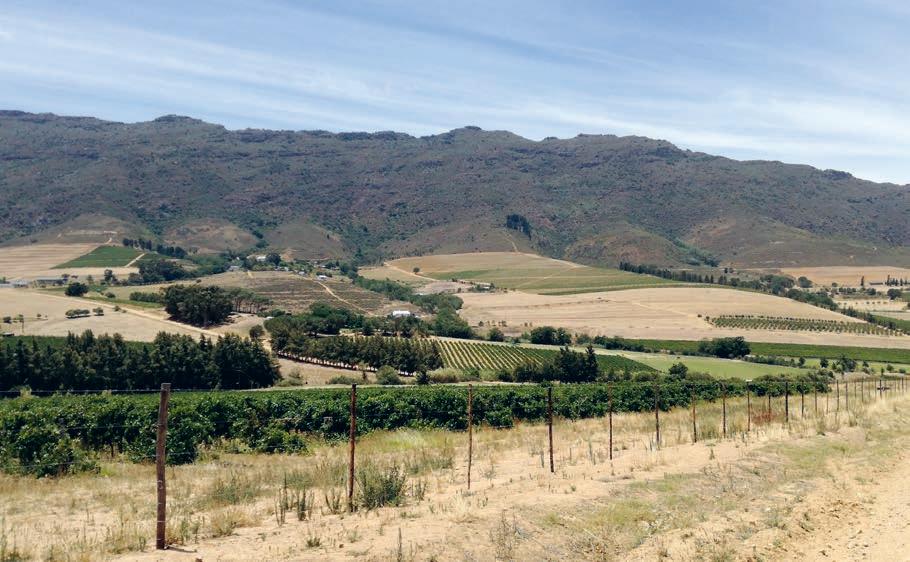

Innovations and collaborations shaping sustainable agriculture to secure Africa’s food future amid climate change.
Whether you buy your food at a high-end supermarket, a spaza shop, a street vendor or a farmers’ market, all produce shares the same origin – a farm. From there, it’s a journey through a complex supply chain to your table.
Everyone, everywhere, deserves access to nutritious, affordable food. However, Africa remains one of the world’s most food-insecure regions. As climate change is a signi cant challenge, building a climate-resilient and sustainable food system is a top priority.
Agriculture is under pressure from environmental threats linked to climate change, which are worsened by greenhouse gas emissions. South Africa’s largest sources of greenhouse gas emissions are electricity generation, followed by agriculture, transport and other industries.
“Climatic shifts can increase exposure to pests and diseases, as changing climate zones can allow these species’ ranges to shift. Additionally, seasonal patterns are beginning to change and uctuate, with some regions experiencing a later rainfall onset,” says Alistair Galloway, a sustainability consultant at BrightWolves South Africa.
“Regenerative agriculture practices have gained signi cant momentum in recent years, strengthening farmers’ resilience to climate-related shocks and stress events. Likewise, precision farming is experiencing notable expansion as it offers farmers an opportunity to cut input and operating costs over the long term,” says Galloway. Gerhard Stander, director of retail and agriculture at
By JENNIFER BOOTH
CHEP Sub-Saharan Africa, highlights that the challenge in Africa is not only producing food, but also protecting it during the journey to consumers. Signi cant quantities are lost after harvesting due to inef ciencies in handling, storage and transportation.
CHEP, a global leader in sustainable logistics, employs a circular economy model.
“Our share-and-reuse model replaces the traditional ‘take, make, waste’ approach,” he says. “By pooling pallets, crates and containers, we keep resources in circulation for longer, cutting down on single-use packaging, lowering carbon emissions and minimising waste. This ensures produce moves quickly and safely from farm to market, while conserving natural resources.”
Agbiz CEO Theo Boshoff says agroprocessors and input suppliers may face carbon taxes and emission limits under the climate change legislation, while farmers will carry these costs indirectly through electricity and diesel. “Companies undertaking carbon-intensive manufacturing operations must measure and report emissions by law, a process that can be expensive.
“Reporting is not mandatory for all entities across the value chain. However, businesses that are not required to do so are increasingly measuring their environmental impact due to market and nancier demands,” he adds.
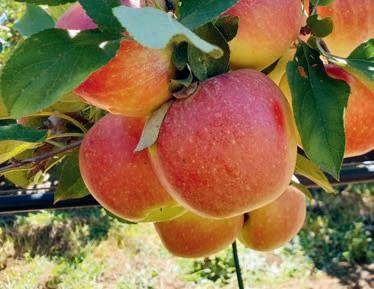
“WE NEED GLOBAL PARTNERSHIPS TO SHARE STRATEGIES, DATA AND RESEARCH ON CLIMATE-RESILIENT CROPS.” – TAMARA MURUETAGOIENA
“Government, industry and universities are working together to set sectoral emission targets, develop supportive policies and advance research, while the private sector engages to access the latest climate-related knowledge,” says Boshoff.
Tamara Muruetagoiena, vice president of sustainability at the International Fresh Produce Association (IFPA), says climate change knows no borders, making international collaboration essential. “We need global partnerships to share strategies, data and research on climate-resilient crops,” she says, adding that such collaboration provides a roadmap for the industry through shared standards and best practices.
Wouter Conradie, director of NSF for food production and services in Africa, highlights the international standards shaping modern farming:
• GLOBALG.A.P. drives water ef ciency, pest management and soil health.
• LEAF Marque adds carbon tracking, renewable energy and regenerative practices.
• Rainforest Alliance promotes agroforestry and drought-resilient crops.
• The SIZA Environmental Standard manages and reports on environmental risks and sustainability practices.
“Together, these frameworks embed climate-smart practices into farm systems, protecting biodiversity, conserving resources and helping farmers adapt to climate risks, while securing access to global markets,” Conradie explains.
Achieving food security and sustainability requires all stakeholders to support sustainable agricultural practices.
Follow: Theo Boshoff www.linkedin.com/in/theo-boshoff-39a541ba
Tamara Muruetagoiena www.linkedin.com/in/tamara-muruetagoiena-67a77416
Wouter Conradie www.linkedin.com/in/wouter-conradie-5b754529
Being a young woman in South African agriculture is both a privilege and a struggle, so says Ipeleng Kwadi Seboni, a North West farmer and national convenor of Youth in Agriculture and Rural Development (YARD). “You carry the responsibility of feeding a nation, but you’re constantly ghting for recognition in a system that doesn’t make space for you.”
Seboni points to the systemic barriers holding women back: limited access to land, nance and credit. She also highlights the cultural and institutional hurdles that have historically undervalued women’s contributions. “For decades, women’s work in agriculture has been made invisible or exploited. Too often, we are marginalised when it comes to policies, land reform processes and leadership positions.”
Yet there is hope. Entrepreneurship programmes, mentorship initiatives and targeted training are beginning to equip female farmers with the necessary skills and resources.

“Representation matters,” Seboni stresses. “When a young girl sees another woman managing a herd, running a farm business, or speaking at a national platform, she believes she also can.”
In the North West’s Bojanala region, Tumelo Tshwagong never imagined leading a piggery and cattle business. What began with ve cattle kept at a friend’s property has grown into a diversi ed enterprise run with her husband, Richard, and daughter, Monthati.
The family raise Brahman cattle and run a thriving piggery on their 149-hectare farm. Their next steps include climate-smart practices and indigenous crops like sorghum, beans and morogo.
“For me, as a woman, farming means impacting our community and country, especially as we face food insecurity,” says Tshwagong.
In the Free State, Maneo Lipali arrived at Gilboa farm in Senekal in 2013, knowing little about agriculture. A decade later, her 656-hectare mixed enterprise produces maize, sun owers, soybeans, poultry and a growing Bonsmara herd.
Backed by land reform and economic stimulus support, Lipali has built worker housing and introduced solar power. However, her true investment is in people. “I want to see young people employed, and I only employ youth on the farm,” she says. She advises newcomers to start small. “With farming, you can’t become a millionaire overnight. You have to work hard and be patient.”
AND RENEWAL
In Limpopo, poultry farmer Lindiwe Molele’s journey has been marked by resilience. She launched her egg business in 2018, only to face COVID-19 disruptions and power outages that crippled her incubation system.
At one point, she walked away, but returned after being retrenched. Today, she runs layer and broiler operations powered by solar energy with support from the Industrial Development Corporation. Her incubation cycle now produces 560 eggs per batch. “You cannot have an idea and not bring it to life. If you start, you can grow,” she says.
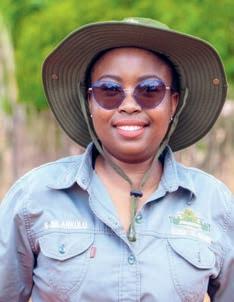
PROGRAMMES, MENTORSHIP
AND TARGETED TRAINING ARE BEGINNING TO EQUIP FEMALE FARMERS WITH THE NECESSARY SKILLS AND RESOURCES.
Also in Limpopo, cousins Maria Salani and Keneilwe Bilankulu turned mining retrenchment into opportunity. Expanding a family plot into six hectares, they now produce vegetables, livestock and poultry through their venture, J. Markeen.
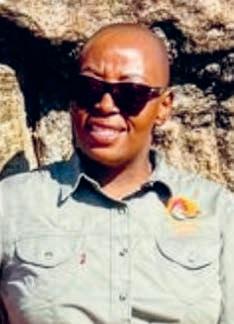

Supplying restaurants and hotels, the business sustains eight jobs while staying true to its organic ethos. “My dad taught us that the land will reward you if you respect it,” says Salani.
These stories prove Seboni’s point: young female farmers are already reshaping South Africa’s food systems. Their determination shows that when women and youth are empowered, they not only secure their own livelihoods, but also plant the seeds of a more food-secure future.
Follow: Ipeleng Kwadi Seboni @IpelengKwadi
Tumelo Tshwagong www.linkedin.com/in/tumelo-tshwagong-b8ba97288
Lindiwe Molele www.linkedin.com/in/lindiwe-molele-87831b362
Keneilwe Bilankulu www.linkedin.com/in/keneilwe-bilankulu-753467200

